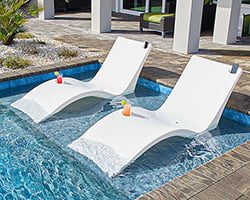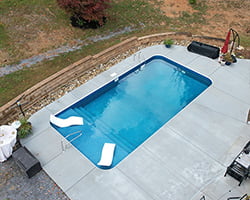Final Swimming Pool Floor Grade: Step 8
Prepping the Bottom
- The rough excavation should be 2” below finished depth.

- Your strings should be set up at finished depth.
- String the pool in sections based on liner manufacturer’s dimensions.
- Place rebar pins at shallow end breakpoints, the pins should be butted up to the walls.
- Locate the front and back sections of the deep end hopper by stretching pins width-wise at proper length (on a 4’ back slope you will place pins 4’ from the back wall at bottom of wall).
- Continue doing this for both width and length of bottom measurements.
- All dimensions are from the top of the panel and not top of coping.
- Find the finished pool bottom grade by using a plumb bob at all string intersection points in the deep end.
- Drive pins into each corner of the hopper at the point of which the plumb bob lands.
- Attach string lines to the pins at the properly finished grade.
- “X” the strings to confirm proper depth on all flat areas.
- Do the same in the shallow end.
- Clean all loose debris, rocks, sticks, etc., from the pool.
Bottom Material
Note: There are varieties of materials to use for pool base, sand/cement, and vermiculite/cement.
- Sand/Cement 5/1 Ratio (sand to cement)
- One ton of sand equals one cubic yard.
- One ton (1 cubic yard) will cover 162 sqft of the area.
- Use Type II Portland cement.
- Mason sand is the best and cleanest to use.
Formula for Sand/Cement Mixture
- Determine the surface area of the pool (length x width) a 16’ x 32’ pool is 512 sqft.
- Multiply by 1.15 (512*1.15=588.88 sqft) this is the total area to be covered by the bottom mixture.
- One cubic yard of sand will cover 162 sqft. So divide total area by 162 (588.88/162=3.363 cubic yards or 2000*3.63=7270.00 pounds of sand).
- Divide pounds of sand by 5 (5 to 1 ratio) 7270/5=1454.00 lbs of cement.
- Check on the weight of Portland cement bags and divide pounds of cement by bag weight for total bags needed.
- The consistency of mix should be like peanut butter.
For vermiculite please review manufactures directions.
Placement Of Sand/Cement Mixture Or Pool Krete
 Troweling the Bottom Material
Troweling the Bottom Material
- THE SMOOTHER, THE BETTER!
- NO rocks or pebbles.
- Trowel from the deep end toward the shallow end.
- Start on back slope.
- Use string lines to confirm material thickness.
To save effort when adding the sand/cement, pool krete or pool base mixture, dump it near the area to be troweled. A certain amount will roll down, but it is easily re-positioned when made to the right consistency. Particular care should be taken with the troweling of the pool kit bottom. The smoothness and evenness of the bottom will determine the appearance of the vinyl pool liner when it is placed in the swimming pool. (There must be NO exposed aggregate)
In order to get maximum compaction and surface smoothness, only thoroughly washed, mason sand (DO NOT USE RIVER SAND) should be mixed with cement in a 5-to-1 (sand-to-cement) ratio. This will allow the finishing operation to proceed smoothly. Inspect the sand finish for sharp, over-sized aggregate.
Note: If a purchased pool base is used, make sure to follow the manufacturer’s instructions. Both sand/cement and pool krete must be mixed using a mixer.
How To Pool Krete Pool Crete Your Swimming Pool Kit
How Much Sand And Cement?
The correct sand-to-cement ratio is 5-to-1. The example below should help.
- Calculate the surface area of the pool. (Example: 20′ x 40′ = 800 square feet)
- Multiply by 15% (.15). (Example: 120)
- Add lines 1 and 2 to arrive at the area to be covered by sand/cement. (Example: 800 + 120 = 920 square feet)
- Divide line 3 by 162. This will tell you how many cubic yards of sand you’ll need. A cubic yard of sand is equal to one ton in weight. Some suppliers will sell by the cubic yard and some will sell by the ton. (Example: 920 ÷ 162 = 5.7 cubic yards, or 11,400 pounds)
- Divide the pounds of sand by 5 to arrive at the 5-to-1 ratio.This will determine how much cement you need. (Example: 11,400 ÷ 5 = 2,280 pounds)
- Divide line 5 by 94 pounds. Most bags of cement are 94 pounds type II (2) Portland cement. This will tell you how many bags of cement you’ll need. (Example: 2,280 ÷ 94 = 24.3 bags)
NOTE: Always order a few extra bags of pool krete, we recommend 10 bags extra. If you use sand/cement and have any extra sand, use it in plumbing trenches.
Final Swimming Pool Floor Grade Questions?
If you have questions about our Final Swimming Pool Floor Grade please feel free to give us a call at 1-800-515-1747 or send us an email, [email protected].
At Pool Warehouse, We Know Swimming Pool Kits!

 Troweling the Bottom Material
Troweling the Bottom Material






 What are our customers saying?
What are our customers saying?

